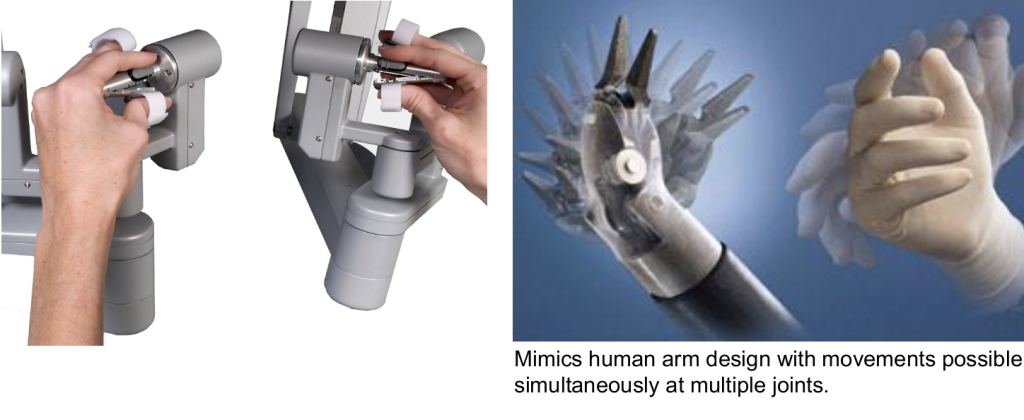What is Robotic surgery?
It is a type of minimally invasive surgery where a surgeon takes assistance from a robotic system to perform the
operation.
That is why it is called Robotic Assisted Surgery (RAS).
How does it work?
The surgeon sits at a console and controls the robotic arms, which have tiny instruments at the end. The robot
provides high definition 3D vision and precise movements.
What are the benefits to the patient?
Robotics surgery offers:
- Less pain and trauma
- Small incisions and scar
- Reduced blood loss
- Greater accuracy
- High precision surgery
- Faster recovery time
How is it different from Laparoscopic surgery?
Laparoscopic surgery
- Vision- 2D
- Movement- 4 degrees
- Magnification- 2x
- Camera control- In assistant’s hands
- Precision- Good
Robotic surgery
- Vision- 3D
- Movement- 7 degrees
- Magnification- 10x
- Camera control- In surgeon’s hands
- Precision- Very good
Finger Tip Control

7 Degrees of Freedom of Movement
Better Vision
Motion Scaling & Tremor Filtration
- 3:1 Scaled down movement
- Stable Platform with Tremor Filtration
Patient experiences less Pain
What types of surgeries can be performed robotically?
Gynaecological surgeries:
- Both benign & malignancy
Uses Of Robotic Surgery in Benign Gynaecology
Commonly used robot-assisted surgical procedure
Endometriosis, DIE
Uterine fibroids/leiomyoma – Myomectomy
Pelvic organ prolapse – Sacrocolpopexy, Pectopexy
Chronic pelvic pain
Hysterectomy
Fallopian tube re-anastomosis
Uses of Robotic Surgery in Gynae Cancers
Malignant condition
- Cervical cancer
- Endometrial cancer
- Lymphadenectomy and sentinel biopsy (dye and fluorescence)
- Ovarian cancer
Commonly used robot-assisted surgical procedure
- Radical hysterectomy, total mesometrial resection (TMMR)
- Hysterectomy, peritoneal mesometrial resection (PMMR)
- Pelvic lymphadenectomy, paraaortic lymphadenectomy
- Staging of early ovarian carcinoma, de-bulking advanced ovarian carcinoma, omentectomy
Is robotic surgery safe?
Yes.
Robotic surgery is safe when performed by a trained and experienced surgeon.
How successful is robotic surgery?
Robot-assisted surgery currently has an overall success rate of above 90%. Individual success rates depend on what type of procedure you need, your general health and other factors.
How long does it take to recover?
Recovery time varies depending on the surgery , but it’s often faster than traditional open surgery.
Can any surgeon perform robotic surgery?
No, surgeons need specialized training and experience to perform robotic surgery.
Why is it called the da Vinci Surgical System?
It was named after the famous Leonardo Da Vinci of fifth century.
His study of human anatomy eventually led to the design of the first known robot in history.
Because of his work on robots and study of human anatomy, the manufacturer says, it was named after him.




